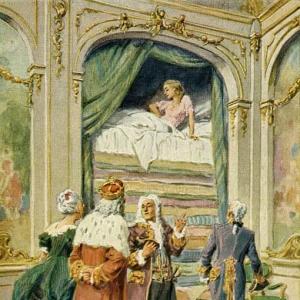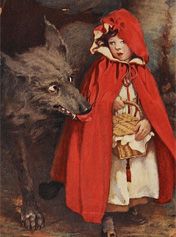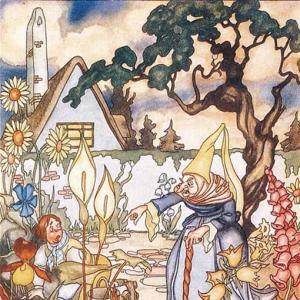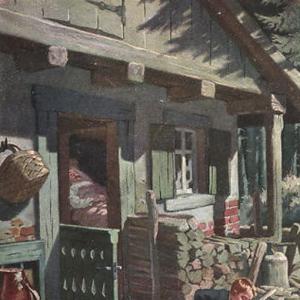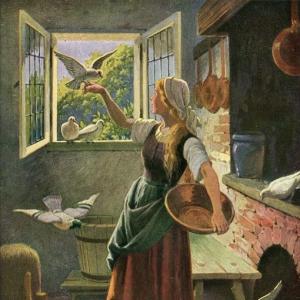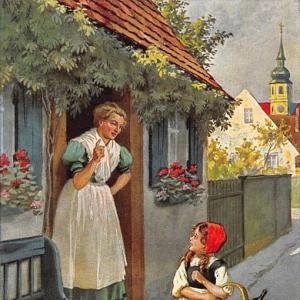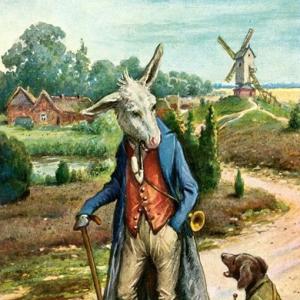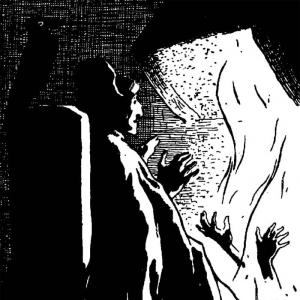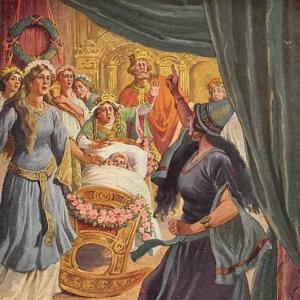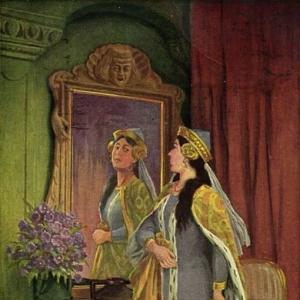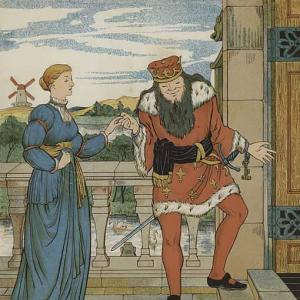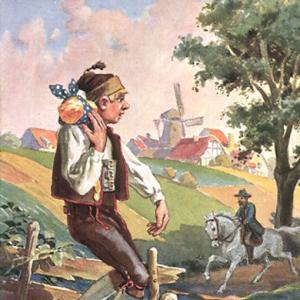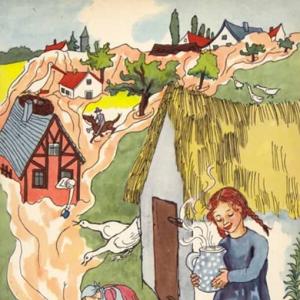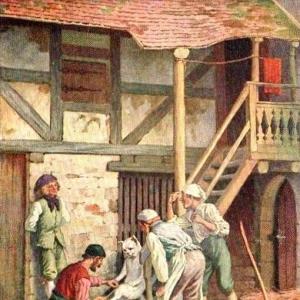Reading time for children: 11 min
There was once a poor Prince, who had a kingdom. His kingdom was very small, but still quite large enough to marry upon; and he wished to marry.
It was certainly rather cool of him to say to the Emperor’s daughter, „Will you have me?“ But so he did. For his name was renowned far and wide; and there were a hundred princesses who would have answered, „Yes!“ and „Thank you kindly.“ We shall see what this princess said. Listen!
It happened that where the Prince’s father lay buried, there grew a rose tree–a most beautiful rose tree, which blossomed only once in every five years, and even then bore only one flower, but that was a rose! It smelt so sweet that all cares and sorrows were forgotten by him who inhaled its fragrance.
And furthermore, the Prince had a nightingale, who could sing in such a manner that it seemed as though all sweet melodies dwelt in her little throat.
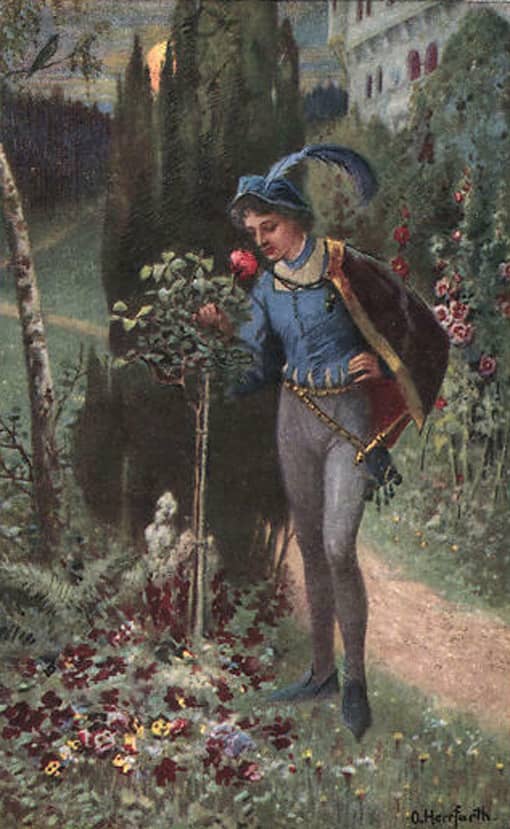 Image: Oskar Herrfurth (1862-1934)
Image: Oskar Herrfurth (1862-1934)So the Princess was to have the rose, and the nightingale; and they were accordingly put into large silver caskets, and sent to her.
The Emperor had them brought into a large hall, where the Princess was playing at „Visiting,“ with the ladies of the court; and when she saw the caskets with the presents, she clapped her hands for joy.
„Ah, if it were but a little pussy-cat!“ said she; but the rose tree, with its beautiful rose came to view.
„Oh, how prettily it is made!“ said all the court ladies.
„It is more than pretty,“ said the Emperor, „it is charming!“
But the Princess touched it, and was almost ready to cry.
„Fie, papa!“ said she. „It is not made at all, it is natural!“
„Let us see what is in the other casket, before we get into a bad humor,“ said the Emperor. So the nightingale came forth and sang so delightfully that at first no one could say anything ill-humored of her.
„Superbe! Charmant!“ exclaimed the ladies. For they all used to chatter French, each one worse than her neighbor.
„How much the bird reminds me of the musical box that belonged to our blessed Empress,“ said an old knight. „Oh yes! These are the same tones, the same execution.“
„Yes! yes!“ said the Emperor, and he wept like a child at the remembrance.
„I will still hope that it is not a real bird,“ said the Princess.
„Yes, it is a real bird,“ said those who had brought it.
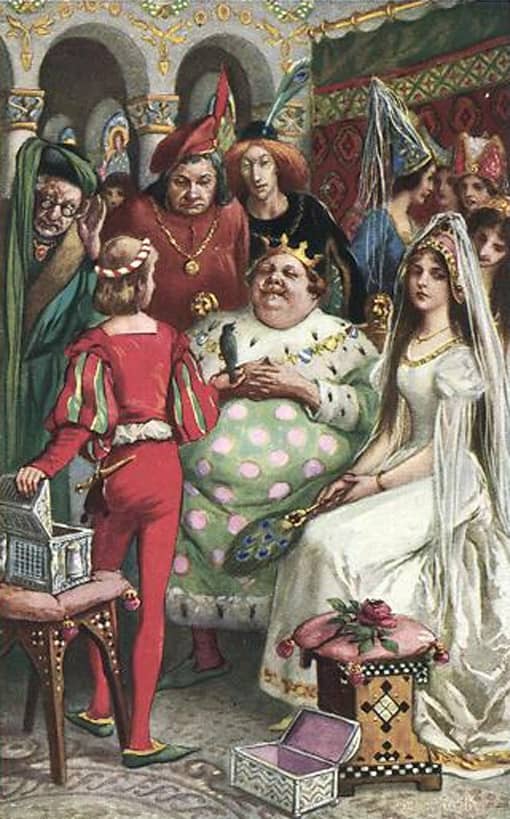 Image: Oskar Herrfurth (1862-1934)
Image: Oskar Herrfurth (1862-1934)„Well then let the bird fly,“ said the Princess; and she positively refused to see the Prince.
However, he was not to be discouraged. He daubed his face over brown and black; pulled his cap over his ears, and knocked at the door.
„Good day to my lord, the Emperor!“ said he. „Can I have employment at the palace?“
„Why, yes,“ said the Emperor. „I want some one to take care of the pigs, for we have a great many of them.“
So the Prince was appointed „Imperial Swineherd.“ He had a dirty little room close by the pigsty; and there he sat the whole day, and worked. By the evening he had made a pretty little kitchen-pot. Little bells were hung all round it; and when the pot was boiling, these bells tinkled in the most charming manner, and played the old melody,
„Ach! du lieber Augustin,
Alles ist weg, weg, weg!“*
* „Ah! dear Augustine! All is gone, gone, gone!“
But what was still more curious, whoever held his finger in the smoke of the kitchen-pot, immediately smelt all the dishes that were cooking on every hearth in the city–this, you see, was something quite different from the rose.
Now the Princess happened to walk that way; and when she heard the tune, she stood quite still, and seemed pleased. For she could play „Lieber Augustine“. It was the only piece she knew; and she played it with one finger.
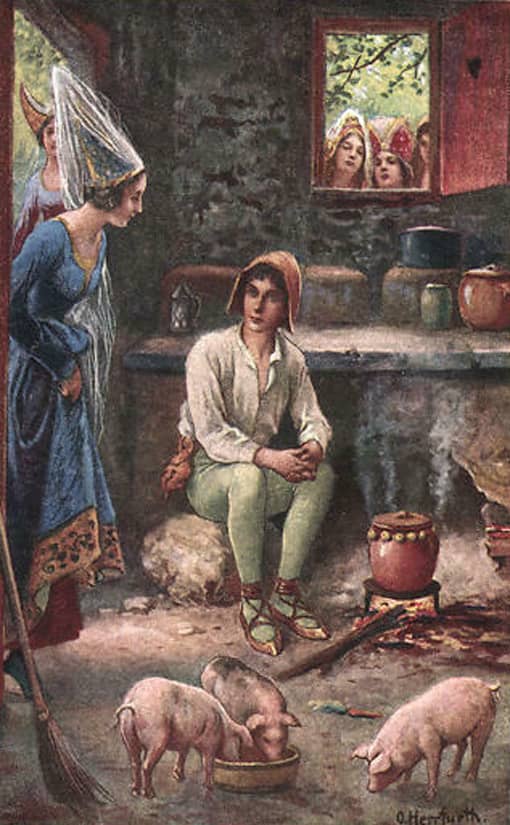 Image: Oskar Herrfurth (1862-1934)
Image: Oskar Herrfurth (1862-1934)„Why there is my piece,“ said the Princess. „That swineherd must certainly have been well educated! Go in and ask him the price of the instrument.“
So one of the court-ladies must run in. However, she drew on wooden slippers first.
„What will you take for the kitchen-pot?“ said the lady.
„I will have ten kisses from the Princess,“ said the swineherd.
„Yes, indeed!“ said the lady.
„I cannot sell it for less,“ rejoined the swineherd.
„He is an impudent fellow!“ said the Princess, and she walked on; but when she had gone a little way, the bells tinkled so prettily
„Ach! du lieber Augustin,
Alles ist weg, weg, weg!“
„Stay,“ said the Princess. „Ask him if he will have ten kisses from the ladies of my court.“
„No, thank you!“ said the swineherd. „Ten kisses from the Princess, or I keep the kitchen-pot myself.“
„That must not be, either!“ said the Princess. „But do you all stand before me that no one may see us.“
And the court-ladies placed themselves in front of her, and spread out their dresses–the swineherd got ten kisses, and the Princess–the kitchen-pot.
That was delightful! The pot was boiling the whole evening, and the whole of the following day. They knew perfectly well what was cooking at every fire throughout the city, from the chamberlain’s to the cobbler’s. The court-ladies danced and clapped their hands.
„We know who has soup, and who has pancakes for dinner today, who has cutlets, and who has eggs.
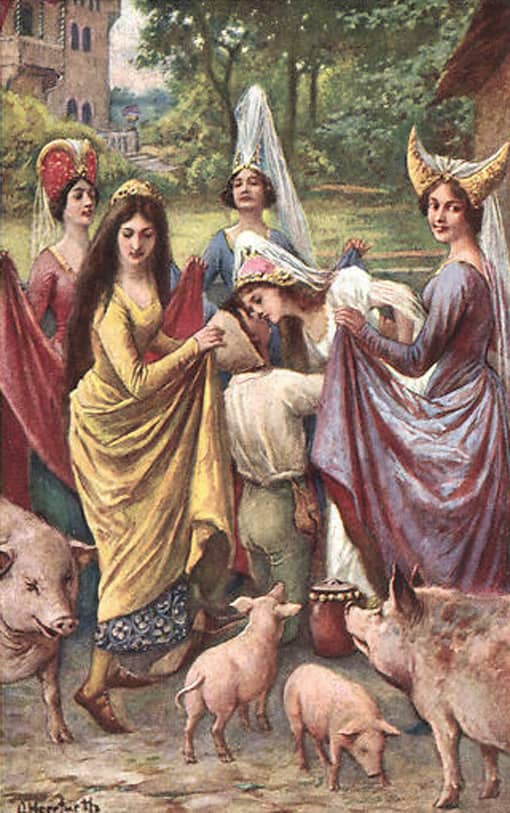 Image: Oskar Herrfurth (1862-1934)
Image: Oskar Herrfurth (1862-1934)How interesting!“
„Yes, but keep my secret, for I am an Emperor’s daughter.“
The swineherd–that is to say–the Prince, for no one knew that he was other than an ill-favored swineherd, let not a day pass without working at something. He at last constructed a rattle, which, when it was swung round, played all the waltzes and jig tunes, which have ever been heard since the creation of the world.
„Ah, that is superbe!“ said the Princess when she passed by. „I have never heard prettier compositions! Go in and ask him the price of the instrument; but mind, he shall have no more kisses!“
„He will have a hundred kisses from the Princess!“ said the lady who had been to ask.
„I think he is not in his right senses!“ said the Princess, and walked on, but when she had gone a little way, she stopped again. „One must encourage art,“ said she, „I am the Emperor’s daughter. Tell him he shall, as on yesterday, have ten kisses from me, and may take the rest from the ladies of the court.“
„Oh–but we should not like that at all!“ said they. „What are you muttering?“ asked the Princess. „If I can kiss him, surely you can. Remember that you owe everything to me.“ So the ladies were obliged to go to him again.
„A hundred kisses from the Princess,“ said he, „or else let everyone keep his own!“
„Stand round!“ said she; and all the ladies stood round her whilst the kissing was going on.
„What can be the reason for such a crowd close by the pigsty?“ said the Emperor, who happened just then to step out on the balcony. He rubbed his eyes, and put on his spectacles. „They are the ladies of the court. I must go down and see what they are about!“ So he pulled up his slippers at the heel, for he had trodden them down.
As soon as he had got into the court-yard, he moved very softly, and the ladies were so much engrossed with counting the kisses, that all might go on fairly, that they did not perceive the Emperor. He rose on his tiptoes.
„What is all this?“ said he, when he saw what was going on, and he boxed the Princess’s ears with his slipper, just as the swineherd was taking the eighty-sixth kiss.
„March out!“ said the Emperor, for he was very angry; and both Princess and swineherd were thrust out of the city.
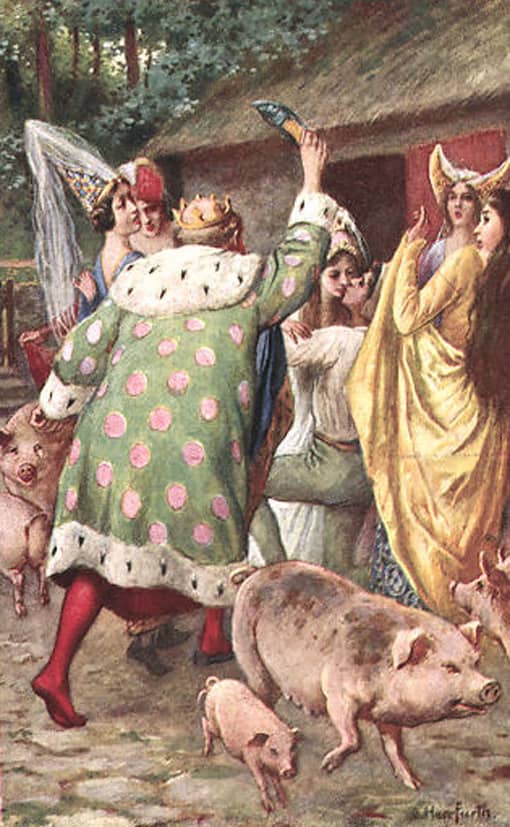 Image: Oskar Herrfurth (1862-1934)
Image: Oskar Herrfurth (1862-1934)The Princess now stood and wept, the swineherd scolded, and the rain poured down.
„Alas! Unhappy creature that I am!“ said the Princess. „If I had but married the handsome young Prince! Ah! how unfortunate I am!“
And the swineherd went behind a tree, washed the black and brown color from his face, threw off his dirty clothes, and stepped forth in his princely robes. He looked so noble that the Princess could not help bowing before him.
„I am come to despise thee,“ said he. „Thou would’st not have an honorable Prince! Thou could’st not prize the rose and the nightingale, but thou wast ready to kiss the swineherd for the sake of a trumpery plaything. Thou art rightly served.“
He then went back to his own little kingdom, and shut the door of his palace in her face. Now she might well sing,
„Ach! du lieber Augustin,
Alles ist weg, weg, weg!“
 Learn languages. Double-tap on a word.Learn languages in context with Childstories.org and Deepl.com.
Learn languages. Double-tap on a word.Learn languages in context with Childstories.org and Deepl.com.Backgrounds
Interpretations
Adaptions
Summary
Linguistics
„The Swineherd“ is a fairy tale written by Danish author Hans Christian Andersen, first published in 1841. Andersen is a prominent figure in the world of literature, known for his vast collection of fairy tales that have been translated into over a hundred languages. Some of his other well-known works include „The Little Mermaid,“ „The Ugly Duckling,“ „The Emperor’s New Clothes,“ and „The Snow Queen.“
Hans Christian Andersen was born on April 2, 1805, in Odense, Denmark. He came from a humble background, with his father working as a shoemaker and his mother as a washerwoman. Despite his family’s poverty, Andersen grew up surrounded by literature and the arts, as his father would read to him and introduced him to theater.
As a young man, Andersen moved to Copenhagen to pursue a career in the arts. He faced several challenges and rejections before finding success as a writer. In 1835, Andersen published his first collection of fairy tales titled „Fairy Tales Told for Children.“ Over the years, he continued to write and publish numerous stories, poems, and plays, solidifying his legacy as a beloved author of children’s literature.
Andersen’s fairy tales often feature elements of fantasy and magic, as well as moral lessons that resonate with readers of all ages. His stories have been adapted into various forms of media, including film, television, and theater, ensuring that his work continues to be cherished and celebrated by generations of readers.
„The Swineherd“ can be interpreted in various ways, highlighting different themes and morals.
The value of inner beauty: The story showcases the importance of appreciating inner beauty and virtue rather than superficial appearances. The princess dismisses the prince’s genuine gifts – the magical rose tree and the nightingale – but is easily captivated by the trinkets created by the disguised prince. The prince, in turn, rejects the princess for her superficiality and inability to recognize true worth.
The consequences of pride and vanity: The princess’s pride and vanity lead her to make poor decisions, ultimately causing her to lose the prince’s affection. She is unable to see beyond appearances and material possessions, which results in her downfall.
The importance of humility and modesty: In contrast to the princess, the prince demonstrates humility by willingly taking on the role of a lowly swineherd to teach the princess a lesson. By doing so, he exposes her shallow nature and reveals his true character.
The deceptive nature of appearances: The story also highlights the deceptive nature of appearances, as the prince disguises himself as a swineherd to interact with the princess. The princess fails to recognize the true value of the prince’s gifts or his true identity, proving that appearances can be misleading.
Encouraging appreciation for art and nature: The tale emphasizes the value of art and nature through the magical rose tree and the nightingale. The prince’s genuine gifts are symbols of beauty and harmony that the princess should have appreciated, demonstrating that one should value and cherish the wonders of art and nature.
„The Swineherd“ is a classic fairy tale that has inspired many adaptations in different forms of media. Here are a few notable examples.
Film adaptations: The story has been adapted into several films over the years, including the 1959 Czechoslovakian film „The Swineherd“ and the 1971 Russian animated film „The Swineherd and the Shepherd“. In 2005, a German film called „Der Schweinehirt“ was released, which was a modern retelling of the story set in a high school.
Musical adaptations: „The Swineherd“ has also been adapted into several musical productions, including the 1967 Broadway musical „Illya Darling“ and the 2009 Off-Broadway musical „The Swine Palace“. The story has also been turned into a ballet called „The Nightingale and the Rose“.
Literary adaptations: The story has been retold in various forms of literature, including picture books for children, young adult novels, and even adult romance novels. One notable example is „The Goose Girl“ by Shannon Hale, which is a retelling of „The Swineherd“ set in a fictional kingdom.
Television adaptations: „The Swineherd“ has been adapted into several television shows, including the 1984 episode of the British TV series „Faerie Tale Theater“ and the 2015 episode of the American TV series „Once Upon a Time“.
Overall, „The Swineherd“ has proven to be a versatile and enduring story that continues to inspire adaptations in various forms of media. Its themes of love, deception, and social commentary remain relevant to audiences of all ages and backgrounds.
„The Swineherd“ is a fairy tale by Hans Christian Andersen about a poor prince who desires to marry the emperor’s daughter. He sends her a magical rose tree that only blooms every five years and a nightingale with a beautiful song. However, the princess is unimpressed with the gifts and refuses to meet the prince. Disguised as a swineherd, the prince obtains a job at the palace and creates magical kitchenware to attract the princess’s attention. Intrigued, the princess agrees to exchange kisses with the swineherd for his creations.
When the emperor discovers the exchange, he expels the princess and the swineherd from the city. The swineherd then reveals his true identity as the prince and condemns the princess for her superficiality, choosing not to marry her. The prince returns to his kingdom, leaving the princess to lament her poor choices and missed opportunity.
„The Swineherd“ by Hans Christian Andersen is a fairy tale that vividly encapsulates themes of superficiality, value, and consequence through its narrative and character interactions.
Here’s a linguistic analysis of the tale:
Style and Tone
The story employs a fairy-tale style marked by an omniscient narrative voice and a didactic tone. Andersen’s language is simple yet evocative, aiming to engage both children and adult readers. The tone is slightly ironic, especially when depicting the absurdity of the characters‘ actions.
Use of Repetition
Repetition is a key stylistic feature in the tale, seen with phrases like “Ach! du lieber Augustin, Alles ist weg, weg, weg!” This not only acts as a motif but also emphasizes the Princess’s folly and the broader theme of losing true value for temporary gains.
Symbolism
The Rose and the Nightingale: These gifts symbolize genuine beauty and authentic value. Their rejection by the Princess hints at her inability to appreciate true worth and depth.
The Kitchen-pot and Rattle: In contrast, these items represent superficial allure. Their appeal to the Princess underscores a preference for novelty and triviality over substance.
Characterization and Dialogue
The Prince/Swineherd: He uses clever disguise and tests the Princess, revealing layers to both his character and hers. His language when disguised as a swineherd is straightforward and transactional, underscoring his cunning and persistence.
The Princess: Her superficial nature is highlighted through her dialogue and actions. She speaks in a petulant and whimsical manner, indicative of immaturity and vanity. Her insistence on trivial comforts over genuine worth is central to her character arc.
Themes
Superficiality vs. Genuine Value: The tale interrogates the value placed on appearance versus true worth. The Princess ignores the profound gifts but yearns for trivial playthings, leading to her downfall.
Consequences of Choices: Andersen integrates a moral lesson about consequences—the Princess’s lack of discernment leads to her public disgrace and personal regret.
Social Satire: Andersen subtly critiques the aristocracy and social norms, mirroring societal faults like vanity and materialism.
Imagery and Sensory Language: Andersen’s descriptions of the rose and nightingale invoke sensory imagery, contrasting sharply with the mechanical but enchanting allure of the swineherd’s contraptions.
Interjections and Exclamations: The use of phrases like “Superbe! Charmant!” and “Fie, papa!” convey the emotional spontaneity and caprice that define the Princess and her court, capturing the frivolous courtly atmosphere.
Structure
The story follows a linear structure typical of fairy tales, with an introduction, rising action, climax, and a moralistic resolution. This predictable arc supports the didactic function of the narrative, making the moral lesson accessible to readers.
In sum, „The Swineherd“ utilizes simple yet rich language to satirically explore themes of worth, vanity, and consequence through its vivid characters and symbol-laden plot. Andersen’s narrative invites readers to reflect on the nature of true value beyond mere appearances.
Information for scientific analysis
Fairy tale statistics | Value |
|---|---|
| Translations | DE, EN, DA, ES, FR, IT, NL |
| Readability Index by Björnsson | 24.4 |
| Flesch-Reading-Ease Index | 87.3 |
| Flesch–Kincaid Grade-Level | 3.7 |
| Gunning Fog Index | 6.3 |
| Coleman–Liau Index | 8.3 |
| SMOG Index | 8 |
| Automated Readability Index | 3.3 |
| Character Count | 8.271 |
| Letter Count | 6.157 |
| Sentence Count | 140 |
| Word Count | 1.501 |
| Average Words per Sentence | 10,72 |
| Words with more than 6 letters | 205 |
| Percentage of long words | 13.7% |
| Number of Syllables | 1.927 |
| Average Syllables per Word | 1,28 |
| Words with three Syllables | 97 |
| Percentage Words with three Syllables | 6.5% |

